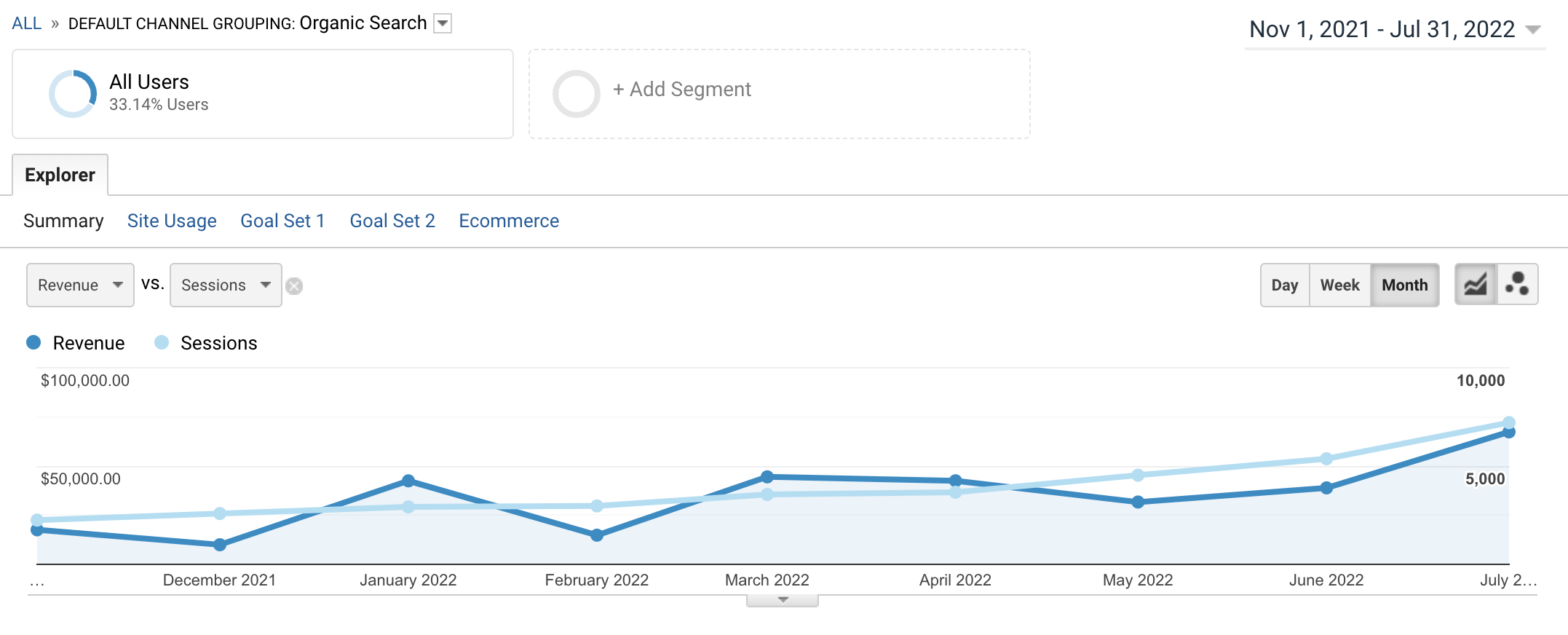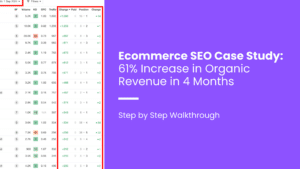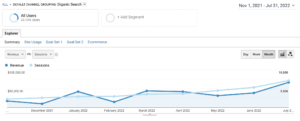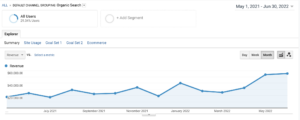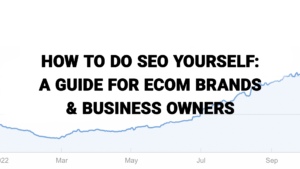One of the most powerful aspects of SEO is the ability for your website traffic and revenue to compound over time. That is, as long as you’re attracting the right kind of traffic.
As you’ll see in this Ecommerce SEO Case Study, we were able to help this brand not only steadily increase traffic over the first 9 months working with us, but that traffic increase also brought with it an increase in organic revenue.
Why was there a strong correlation between their traffic and revenue growth? We were able to help them earn traffic with buying intent that was directed toward the brand’s most important product and collection pages.
The end result was a 283% increase in organic revenue and a 220% increase in organic traffic in just 9 months!
Let’s dig into the details of this successful SEO campaign.
Where They Started
Prior to working with us, this brand had been seeing a drop in organic traffic and had inconsistent organic revenue. This was a problem the brand had not had in previous years, so they wanted to work with an SEO agency that could help them recover lost traffic and regain the consistent sales they were used to.
Some of the reasons they had seen a drop off were due to their previous agency being unable to deliver consistent blog and content creation, backlink building, and handling on-page and technical SEO issues.
If there’s one thing that matters in SEO, it’s consistency, and they were tired of paying for an agency that provided an inconsistent experience when it came to deliverables.
To kick things off with us, we ran a comprehensive SEO audit and put together an SEO Action Plan that we were confident would lead to success.
SEO Audit Findings
Knowing that this site had had previous SEO success in the past, we anticipated our audit would find some key on-page and technical issues that were currently holding the site back from ranking higher on Google.
In addition to those issues, we wanted to look at how the lack of content creation and backlink building were impacting the website’s ability to compete online.
Here were some of our key findings from the audit.
On-Page & Technical SEO Issues
Our audit uncovered a handful of on-page and technical SEO issues including:
- 404 errors
- CTR or click-thru rate issues
- Lack of internal links
- Crawl depth issues
- 302 redirects
- Broken links
Let’s walk through how each of these were negatively impacting this website.
404 Errors
A 404 error is when someone is attempting to access a page that no longer exists. It can be okay for a page to 404, and many due after they have been deleted, but the issues arise when a page that has been deleted has existing backlinks and internal links pointing to them.
With a proper 301 redirect in place for the 404 page, those backlinks could pass authority to another page and the internal links could navigate website visitors to an appropriate alternative page for a better user experience.
CTR Issues
CTR or Click-Thru Rate is when a page is showing up on Google and earning impressions, but is not earning very many clicks from those impressions.
A low CTR can be the result of underoptimized meta titles, not ranking high enough, or from when pages are aligned with the wrong keywords.
With this website, they had recently gone through a major redesign and many of the new pages had not been optimized once the redesign went live.
Lack of Internal Links
Internal links are a powerful and underutilized SEO tactic that can move the needle for your most important keywords.
An internal link is when one page on your website links to another via keyword-rich anchor text. For example, a blog post that talks about the features and benefits of one of your collections that links to that collection page within a paragraph that mentions the keyword that the collection page is trying to rank for.
This website had not been utilizing this tactic even though the content on the site provided plenty of opportunities to do so.
Crawl Depth Issues
Crawl Depth is when pages on your website are more than a handful of clicks away from the homepage. This can make it hard for both users and Google to crawl and find these pages which creates a negative user experience and makes it harder for pages to index and rank.
302 Redirects
A 302 redirect is fine to use for a while and that is because it is telling your web server and the internet that this is a temporary redirect. Having too many of these or allowing them to be permanent can slow your website down.
Broken Links
A broken link is when a link on your website points to a page that no longer exists or is using a URL that is broken. This creates a bad user experience and can also hurt the ability of your site to pass authority across all of your pages and impact how Google crawls and understands your website.
Content & Backlink Building Gaps
Given that this website had several newer collection pages and a large number of new products, we identified the need to restart content production. New blog posts would help educate searches on the products and also help support collection and product pages from a keyword ranking perspective by adding topical relevance to the website.
Additionally, many of the competitors this client was up against had a more robust backlink profile. Not only did they have more authority, but they were also building more links consistently, whereas our client had not been building any links at all in recent months!
What We Did
On-Page & Technical SEO Fixes
Here’s a breakdown of how we addressed the On-Page & Technical SEO Fixes.
404 errors
We analyzed the 404 errors to see if the deleted pages had existing backlinks or internal links pointing to them. Then we redirected the ones that did to an appropriate alternative page.
CTR or click-thru rate issues
We began updated meta titles and descriptions. Making sure to keep them at an appropriate length and mixing in call to action phrases and secondary keywords to increase buying intent and keyword exposure where possible.
Lack of internal links
We analyzed existing content for internal link opportunities and then also mapped out how new pieces of content would provide new internal linking opportunities for our top priority pages.
Crawl depth issues
While the internal links we added helped reduce the crawl depth for some of the pages that were too deep in the site architecture, we also helped rework the main navigation to reduce the number of clicks it took to get to some of the product and collection pages.
302 redirects
We updated the 302 redirects to 301 redirects where appropriate.
Broken links
There are two ways to fix broken links. One is to redirect the broken URLs, the other is to manually go in and change the broken link. Manually changing the links provides a cleaner experience for both users and web crawlers, so we took the time to fix these links one by one.
Content Creation
Anytime you have new collection pages and products, it can be helpful to create content to support those pages. We mapped out the questions and related topics that would help make this client a topical authority on these new collection and product pages and then got to work on producing 2 to 3 pieces of content per month.
Backlink Building
With backlinks being one of the most important ranking signals, we got to work on researching and prospecting websites that we could reach out to and build links with. Our approach considers the niche of the client and the quality of the site we’re earning links from. Ideally we want links from websites that are topically relevant or at least adjacent to what the client sells and from websites that are ranking well in their own right with real content.
The Results: 283% Increase in Monthly Organic Revenue & 220% Increase in Organic Traffic in 9 Months
In the following graphs, you’ll see the progress made over the first 9 months of this campaign.
In this first graph, you can see that this client was bringing in between 2,500-3,000 organic sessions per month, and by the time we hit the 9-month mark, they were bringing in between 6,000-7,000 sessions per month.
In this second chart, you can see that the inconsistent and underperforming organic revenue turned into consistent revenue that was also growing at a healthy rate. Going from $17,000 in organic revenue to over $67,000 in organic revenue in 9 months just from SEO.
To help illustrate the correlation between traffic growth and revenue, this third chart has both line graphs for traffic and revenue over these 9 months.
As you can see, consistent investment in SEO works when you have a plan in place and work to align content, backlinks, and on-page SEO efforts.
